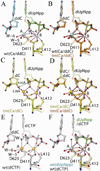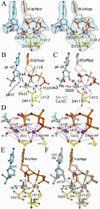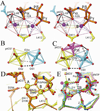Structural insights into complete metal ion coordination from ternary complexes of B family RB69 DNA polymerase
- PMID: 21923197
- PMCID: PMC3760225
- DOI: 10.1021/bi201260h
Structural insights into complete metal ion coordination from ternary complexes of B family RB69 DNA polymerase
Abstract
We have captured a preinsertion ternary complex of RB69 DNA polymerase (RB69pol) containing the 3' hydroxyl group at the terminus of an extendable primer (ptO3') and a nonhydrolyzable 2'-deoxyuridine 5'-α,β-substituted triphosphate, dUpXpp, where X is either NH or CH(2), opposite a complementary templating dA nucleotide residue. Here we report four structures of these complexes formed by three different RB69pol variants with catalytically inert Ca(2+) and four other structures with catalytically competent Mn(2+) or Mg(2+). These structures provide new insights into why the complete divalent metal-ion coordination complexes at the A and B sites are required for nucleotidyl transfer. They show that the metal ion in the A site brings ptO3' close to the α-phosphorus atom (Pα) of the incoming dNTP to enable phosphodiester bond formation through simultaneous coordination of both ptO3' and the nonbridging Sp oxygen of the dNTP's α-phosphate. The coordination bond length of metal ion A as well as its ionic radius determines how close ptO3' can approach Pα. These variables are expected to affect the rate of bond formation. The metal ion in the B site brings the pyrophosphate product close enough to Pα to enable pyrophosphorolysis and assist in the departure of the pyrophosphate. In these dUpXpp-containing complexes, ptO3' occupies the vertex of a distorted metal ion A coordination octahedron. When ptO3' is placed at the vertex of an undistorted, idealized metal ion A octahedron, it is within bond formation distance to Pα. This geometric relationship appears to be conserved among DNA polymerases of known structure.
Figures





References
-
- Steitz TA. DNA- and RNA-dependent DNA polymerases. Curr. Opin. Struct. Biol. 1993;3:31–38.
-
- Joyce CM, Steitz TA. Function and Structure relationship in DNA polymerases. Ann. Rev. Biochem. 1994;63:777–822. - PubMed
-
- Franklin MC, Wang J, Steitz TA. Structure of the replicating complex of a pol alpha family DNA polymerase. Cell. 2001;105:657–667. - PubMed
Publication types
MeSH terms
Substances
Associated data
- Actions
- Actions
- Actions
- Actions
- Actions
- Actions
- Actions
- Actions
- Actions
- Actions
Grants and funding
LinkOut - more resources
Full Text Sources
Miscellaneous

